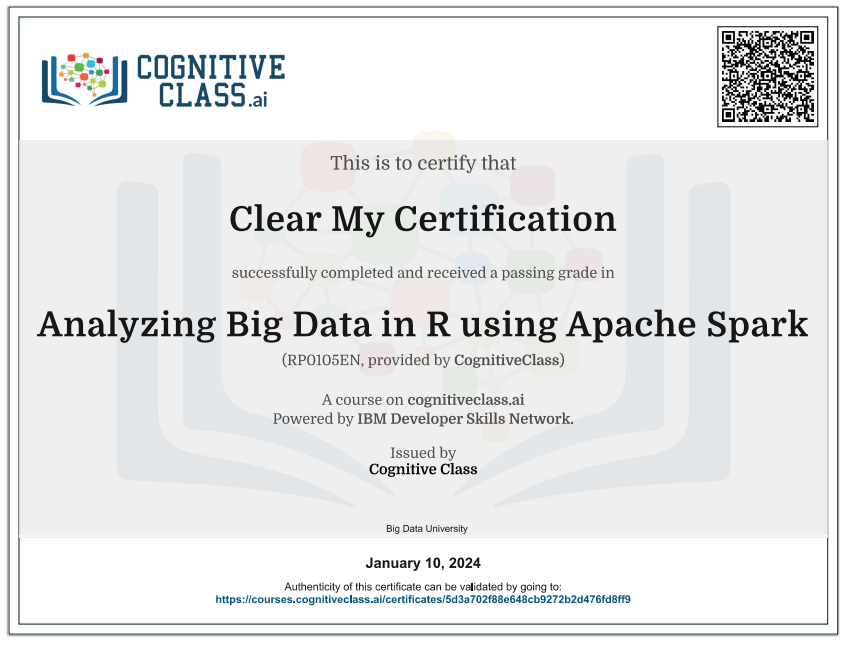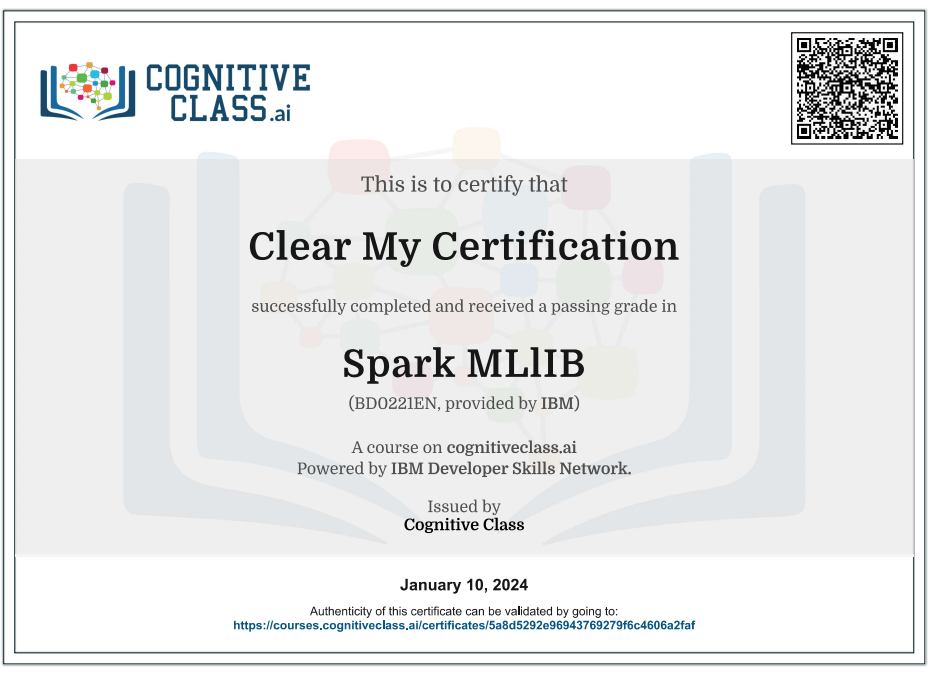Enroll Here: Build an IoT Blockchain Network for a Supply Chain Cognitive Class Exam Answers
Build an IoT Blockchain Network for a Supply Chain Cognitive Class Certification Answers

Lab 1: Build a Blockchain Network Quiz Answers – Cognitive Class
Question 1: The default blockchain Perishable Goods Network in Hyperledger Composer includes which participants? Select all that apply.
- Grower
- Exporter
- Shipper
- Importer
Question 2: Which of these file types is used for a model file?
- BNA
- JS
- CTO
- ACL
Question 3: To capture conditions for a crash, a hard jolt, or other incidents based on the accelerometer data, what field did you add to the Contract asset?
- DateTime arrivalDateTime
- Double maxAccel
- AccelReading[] AccelReadings optional
- ShipmentStatus status
Question 4: What is the purpose of this event: TemperatureThresholdEvent()?
- To notify participants when agreed on temperature thresholds are exceeded
- To alert the delivery vehicle driver or owner when temperatures exceed a specific threshold
- To force the temperature sensor on a delivery vehicle to rest
- To notify participants that the contract has been breached
Question 5: In a DevOps pipeline, what occurs during the BUILD phase? Select all that apply.
- Clones your GitHub repository
- Provisions and configures an instance of the blockchain network
- Runs all of the automated unit tests for all of your smart contracts
- Installs any dependencies
Understand the imported Node-RED flows Quiz Answers – Cognitive Class
Question 1: Which task is not done by the Start Particle Electron flow?
- Sends a command to enable or disable the device geolocation reporting
- Controls the interval of the report
- Queries the temperature blockchain transaction history
- Retrieves accelerometer and current temperature data
Question 2: Which flow takes the arriving data, reformats it, and calls the next flow to write the Particle Electron events to the transaction history of the blockchain network?
- Track Asset History
- Load Blockchain
- Start Particle Electron
- Particle Receiver
Question 3: Which flow sets up a series of GET and POST commands?
- Track Asset History
- Blockchain REST API
- Load Blockchain
- Start Particle Electron
Question 4: The Track Asset History flow filters the array to the selected device and time frame.
- True
- False
Question 5: What is one task that is done by the Load Blockchain flow?
- Sends a command to enable or disable the device geolocation reporting
- Provisions and configures an instance of the blockchain network
- Queries the temperature blockchain transaction history
- Constructs a variety of Node-RED dashboard UI elements
Build an IoT Blockchain Network for a Supply Chain Final Exam Answers – Cognitive Class
Question 1: What is the purpose of exposing the blockchain network as a REST API?
- To allow appropriate participants in the network to update the blockchain contract
- To allow other developers to access the blockchain network
- To allow the network to run on IBM Cloud
- To manipulate the blockchain from Node-RED
Question 2: What is included in the Internet of Things Platform Starter? Select all that apply.
- CouchDB database
- Node-RED Node.js web server
- Cloudant database
- IoT platform service
Question 3: What is the purpose of the ParticleSSE node in the Particle Receiver flow?
- Sends a command to enable or disable the device geolocation reporting
- Sets up a POST command that writes a temperature event into the blockchain as a transaction
- Allows you subscribe to incoming server-sent events (SSE) on a Particle cloud through a persistent connection
- Queries the temperature blockchain transaction history
Question 4: What is the main task of this flow?
- Queries the temperature blockchain transaction history
- Create a UI dashboard to track assets
- Sends a command to enable or disable the device geolocation reporting
- Connects your Node-RED flow to IBM Cloud
Question 5: Hyperledger Composer REST APIs cannot be used by Node-RED to communicate to the blockchain perishable network.
- True
- False
Question 6: What must you add to the model file for the IoT data to be associated with the asset and shipment?
- IoT variables
- A field for the accelerometer value
- Events that alert the appropriate participants when agreed on thresholds are exceeded
- An updated logic.js file
Question 7: When you export the code for your network from Hyperledger Composer, what type of file is created?
- BNA
- JS
- JSON
- ZIP or TAR
Question 8: You use the Google Maps Locator API to triangulate the geographical location of a device.
- True
- False
Question 9: Using a blockchain network for IoT Asset Tracking is an important blockchain use case because it can be used to record an immutable record of the following attributes. Select all that apply.
- Where the asset was located during its journey
- How long the truck driver took a lunch break
- When was the asset at a particular location
- What environmental conditions (temperature, vibration) the asset was exposed to
Question 10: The Particle Electron program is written in which language?
- Java
- C/C++
- Python
- Go
Introduction to Build an IoT Blockchain Network for a Supply Chain
Building an IoT (Internet of Things) blockchain network for a supply chain involves integrating IoT devices with a blockchain platform to enhance transparency, traceability, and security in the supply chain. Below is a high-level overview of the steps involved in creating such a system:
1. Define Requirements:
Clearly outline the requirements and objectives of implementing an IoT blockchain network in the supply chain. Identify the specific use cases and areas where blockchain and IoT integration can add value, such as tracking product provenance, ensuring authenticity, and reducing fraud.
2. Select a Blockchain Platform:
Choose a suitable blockchain platform that aligns with your requirements. Popular platforms for enterprise use include Hyperledger Fabric, Ethereum, and Corda. Ensure the chosen platform supports smart contracts, as they play a vital role in automating transactions and business logic.
3. Set Up the Blockchain Network:
Establish a private or consortium blockchain network. In a consortium model, multiple parties (e.g., suppliers, manufacturers, distributors) can participate in the blockchain network. Configure nodes, establish consensus mechanisms, and define the rules for validating transactions.
4. Design Smart Contracts:
Develop smart contracts to encode the business rules and automate processes within the supply chain. Smart contracts can handle tasks such as recording IoT device data, triggering transactions, and validating the authenticity of products.
5. Integrate IoT Devices:
Connect IoT devices to the blockchain network. This involves embedding sensors and communication modules into physical objects (products, containers, etc.) to collect and transmit data. Ensure secure communication protocols are used to protect the integrity of the data.
6. Data Encryption and Security:
Implement robust security measures to protect data transmitted by IoT devices. Use encryption techniques to secure communications, and consider mechanisms like device authentication and authorization to prevent unauthorized access.
7. Data Storage and Validation:
Record IoT-generated data on the blockchain. Validate and store relevant information such as location, temperature, and timestamp. This creates an immutable and transparent ledger, enabling all participants to trace the journey of products through the supply chain.
8. User Interfaces and Dashboards:
Develop user interfaces and dashboards for stakeholders to interact with the blockchain network. Provide a user-friendly platform for monitoring and analyzing supply chain data, enabling real-time visibility into the movement of goods.
9. Compliance and Standards:
Ensure compliance with industry standards and regulations related to both blockchain and IoT. Consider privacy concerns and data protection regulations when handling sensitive information.
10. Testing and Deployment:
Thoroughly test the integrated system to identify and resolve any issues. Once testing is successful, deploy the IoT blockchain network to the production environment.
11. Continuous Monitoring and Improvement:
Implement monitoring tools to track the performance of the IoT blockchain network continuously. Regularly update smart contracts, security protocols, and other components to adapt to changing requirements and address emerging challenges.
Building an IoT blockchain network for a supply chain requires collaboration among different stakeholders, including manufacturers, suppliers, logistics providers, and retailers. Clear communication and agreement on standards are essential for the successful implementation of such a system.
 Clear My Certification All Certification Exam Answers
Clear My Certification All Certification Exam Answers



